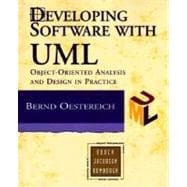
| Preface | p. xi |
| Introduction | p. 1 |
| Introduction | p. 3 |
| Object-Oriented Software Development | p. 4 |
| History of Object-Orientation | p. 5 |
| Making up Your Own Methodology | p. 8 |
| Holistic Approach | p. 11 |
| Suggested Reading | p. 16 |
| Object-Orientation for Beginners | p. 17 |
| Object-Orientation for Beginners | p. 18 |
| Classes, Objects, Instances | p. 19 |
| Attributes, Operations, Constraints | p. 21 |
| Taxonomy and Inheritance | p. 22 |
| Abstract Classes | p. 30 |
| CRC Cards | p. 31 |
| Objects Communicate with Each Other | p. 31 |
| Message Exchange | p. 35 |
| Collections | p. 38 |
| Polymorphism | p. 40 |
| Object Identity | p. 43 |
| Persistence | p. 44 |
| Design Patterns | p. 44 |
| Suggested Reading | p. 47 |
| The Development Process | p. 49 |
| Aims | p. 50 |
| Overview of Development Phases | p. 52 |
| Requirement Analysis | p. 53 |
| Problem Domain Analysis | p. 69 |
| Iterative-Incremental Component Development | p. 72 |
| System Introduction | p. 78 |
| Project Management | p. 79 |
| Suggested Reading | p. 95 |
| Example | p. 97 |
| Analysis | p. 99 |
| Aims | p. 100 |
| Use Case Analysis | p. 100 |
| Application Architecture | p. 112 |
| Technical Dictionary | p. 115 |
| Explorative Prototypes | p. 119 |
| CRC Cards | p. 124 |
| Identifying Business Classes | p. 128 |
| Activity modeling | p. 128 |
| Component building | p. 130 |
| Design | p. 133 |
| Component Design | p. 134 |
| Specifying Dialogs | p. 136 |
| Identifying Domain Classes and Relationships | p. 139 |
| Domain Class Modeling: Business Partner | p. 146 |
| Domain Class Modeling: Reservation and Contract | p. 150 |
| Delimiting Components | p. 155 |
| Specifying Operations | p. 156 |
| Specifying Attributes | p. 158 |
| Modeling Activities | p. 160 |
| Modeling States | p. 161 |
| Modeling Object Interaction | p. 162 |
| Database Connection | p. 163 |
| Fundamentals of the Unified Modeling Language | p. 169 |
| Introduction | p. 171 |
| Types of Diagrams | p. 172 |
| Use Case Diagrams | p. 173 |
| Use Case | p. 174 |
| Actors | p. 178 |
| Use Case Diagram | p. 180 |
| Class Diagrams (Basic Elements) | p. 185 |
| Classes | p. 186 |
| Objects | p. 193 |
| Attributes | p. 195 |
| Operations, Methods | p. 198 |
| Interfaces, Interface Classes | p. 202 |
| Constraints | p. 206 |
| Tagged Values | p. 211 |
| Stereotypes | p. 213 |
| Notes | p. 216 |
| Cooperation/Design Pattern Notation | p. 217 |
| Packages | p. 218 |
| Class Diagrams (Relational Elements) | p. 221 |
| Generalization, Specialization | p. 222 |
| Association | p. 228 |
| Aggregation | p. 243 |
| Dependency Relations | p. 247 |
| Refinement or Realization Relations | p. 248 |
| Behavioral Diagrams | p. 251 |
| Activity Diagrams | p. 252 |
| Collaboration Diagrams | p. 257 |
| Sequence Diagrams | p. 262 |
| State Diagrams | p. 265 |
| Implementation Diagrams | p. 271 |
| Component Diagrams | p. 272 |
| Deployment Diagrams | p. 273 |
| Object Constraint Language | p. 275 |
| Object Constraint Language (OCL) | p. 276 |
| Appendices | p. 285 |
| Glossary | p. 287 |
| References | p. 307 |
| Index | p. 313 |
| Table of Contents provided by Syndetics. All Rights Reserved. |
The New copy of this book will include any supplemental materials advertised. Please check the title of the book to determine if it should include any access cards, study guides, lab manuals, CDs, etc.
The Used, Rental and eBook copies of this book are not guaranteed to include any supplemental materials. Typically, only the book itself is included. This is true even if the title states it includes any access cards, study guides, lab manuals, CDs, etc.